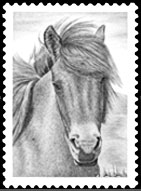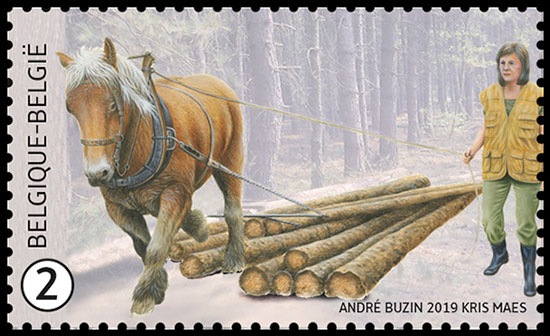
On January 28, 2019, the Belgian Post released a minisheet "Animals At Work."
Since ancient times, animals played a significant role in human life and for many centuries they were loyal helpers in all human activities. People have learned to use the strength, endurance, speed and other qualities of animals in various spheres, such as transport, agriculture, industry, etc. However, with scientific and technological progress, the role of animals has reduced with each passing decade. In our century of incredible technical capabilities and automation, the use of animals now seems anachronistic. And yet we still call on our four-legged helpers to perform specific tasks.
Belgium Post turned to this unusual topic and released a minisheet consisting of five stamps, depicting historical scenes and modern situations related to the use of animals by humans.
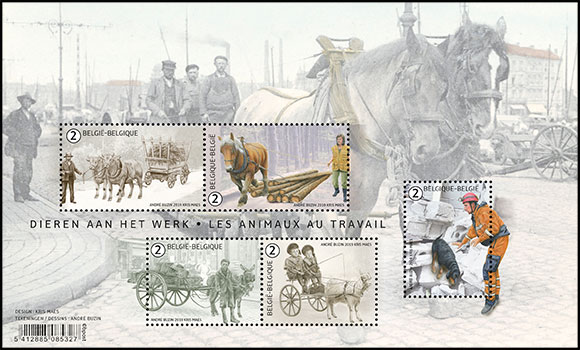
The drawings on the stamps were created by the famous Belgian painter-animalist, André Buzin. He has been cooperating with Belgium Post for many years, but he usually only makes stamps devoted to wild animals and birds. According to the artist, the proposal to work on this topic was unexpected for him, but the subject was interesting, so he agreed. Designer Kris Maes also worked on the creation of this sheet and he was responsible for the overall composition and design of the release. In the process of his work, André Buzin studied a large number of antique photos from the beginning of 20th century, which mainly depicting various draft animals, including; horses, oxen, donkeys and even goats. This allowed the artist to recreate the most reliable images for the postage stamps.
Three stamps in the series, namely: the oxen, the donkey and the goat, form a historical retrospective where André Buzin used sepia coloured paper with a slightly granular surface to help recreate the style of old photos. While the two other stamps, namely: the horse and the rescue dog, were made in colour, creating a bright contrast, underlining the modernity of these stamps as they relate to modern times.
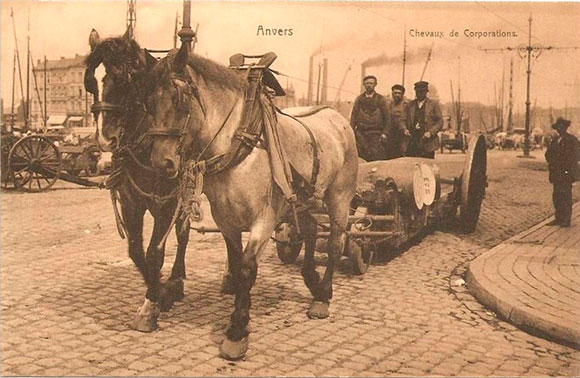
As the background image for the sheet, an old postcard entitled "Guilds horses. Antwerp" was used. That same picture of the cooper's horse carriage was used by both the Brussels publishing house, Nels (series 15, № 17) and the Thill publishing house (series 25, № 49), so it is difficult to determine precisely which card was used as the prototype. For this sheet, the image from the postcard was mirrored.
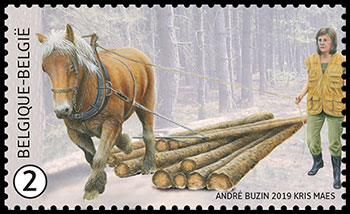
In this sheet, Belgium Post shows us that the horse remains in demand, albeit in specific areas of the economy, such as logging. Almost to the middle of 20th century, horses were actively used in the timber industry for log hauling. Gradually, horses took a back seat as they were replaced by mechanical skidders. Today however, there are places where horses continue to be used for various purposes. Horses are ideally suited for carrying out necessary sanitary felling in reserves and natural parks, and in woods with spawning rivers. After all, the quiet step of the hoof and the light smell of horse sweat is much preferable to tearing the ground with metal caterpillars, or the terrifying roar of engines and diesel exhaust fumes they emit. Small forest farms, where logging is not the main activity, also continue to use horses, which, in the forest, are a perfect alternative to the tractor and forwarder.
Heavy-duty breeds of horses such as Belgian and French Percherons, English Shires and South German Heavy Drafts are used for skidding most often. These horses can track two or three large-sized logs, 12 m long (and more) and weighing up to 800 kg each.
So, even these days, horses can find work, especially since environmental concerns in some countries have come to the fore, which sometimes makes it possible to reconsider priorities, and to opt for greener means and methods of doing business.
Перейти в каталог
